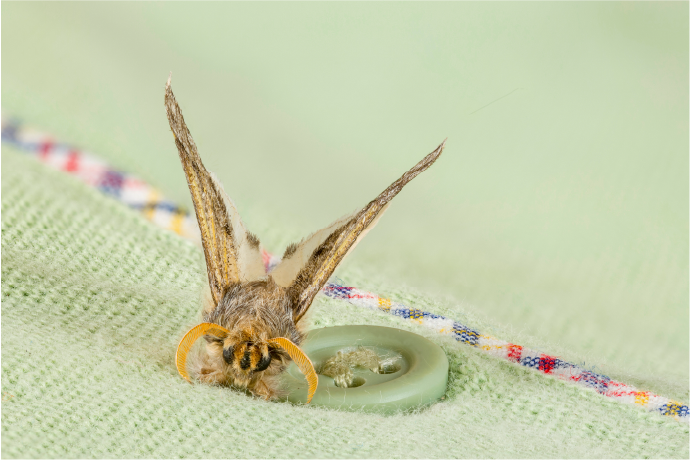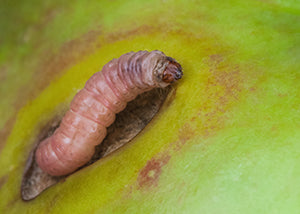The box tree caterpillar is a common pest in the UK, particularly the South East, feeding on box bushes. Without early detection and treatment this can cause devastation to your Buxus. Fortunately, pheromone traps are an easy way to detect and treat box tree infestations.

What is box tree caterpillar?
The box tree caterpillar/moth (Cydalima perspectalis) is the main pest of box bushes (Buxus spp.).
Buxus is a very popular decorative garden plant, commonly used as hedges or topiary plants. They can be shaped to help create structure to a flowerbed and provide year-round green.
The caterpillar transforms into the box caterpillar butterfly or moth, which mate and lay their eggs back on the leaves of your box plants in several cycles between April and October. It’s the caterpillars that cause the actual damage by eating the leaves.

Box tree caterpillar life cycle
How bad is a box tree caterpillar infestation?
A box hedge moth infestation is both rapid and devastating. The caterpillar eats the plants, removing the green appearance, and leaving behind a brown skeleton.
Box tree moths can lay hundreds of eggs (larvae) when they find a bush, which result in vast numbers of hungry caterpillars feeding on individual box hedges.
Because of the high numbers of caterpillars, your box bush is destroyed with devastating speed. Early detection of when moths are present to help you protect your box trees is key.
What are the signs of box tree caterpillar infestation?
Faded or brown patches
A healthy box bush should be green year-round, changing from a light to dark green from spring to summer, as in the image below.

Healthy green Buxus
If you start to see faded or brown patches like the image below, this is a sign that the sneaky box hedge caterpillars are at work.

Buxus damage - faded, brown leaves
Damage tends to start around the base of the bush and expand upwards
White webbing
Another symptom of box caterpillar moth presence is the appearance of white webbing across the box foliage.

Buxus moth caterpillar in webs
The caterpillar produces silk and spins the webs to protect itself.
Will I be able to see the caterpillars in my Buxus?
There will of course be caterpillars on your box plants.
However, the younger caterpillars are often too small to notice at first as an early warning sign.
Once faded or brown patches appear, you’ll start to see swarms of larger caterpillars, which are fairly easy to see.
This is because both the moth and caterpillar form are very distinctive, probably because of their tropical East Asian origin.
The caterpillar has black heads and yellow and black stripes along their green bodies.

Black, green and yellow box caterpillar
The moths are a lot easier to identify early on, before the caterpillars have hatched. They are large and visibly different to other moths, and even white butterflies such as cabbage whites.
The box moths have large white wings (4cm) with a dark brown trim all around the edge. They also have a little white ‘horn’ shapes intruding into the brown trim about halfway up the wing.
The caterpillar has black heads and yellow and black stripes along their green bodies.

Box tree moth with white wings and a brown trim
They can be found resting within the box bush, and will also rest on and around other plants in a garden.
They’re also attracted to light, and so may accidentally enter a house if doors or windows are left open in evenings.
The pupae form, when the caterpillars are transitioning into moths, is hard to see, since they’re brown and hide themselves by sticking to branches.
Could my box tree damage be caused by box blight instead?
Brown patches can be confused with damage from diseases such as box blight, and by the time they appear the box bush attack is already well underway.
Box blight is a rare fungal disease. It also causes brown patches, but on top of that there’ll also be black streaks and diebacks on young stems, and white/pink spores on the underside of leaves.
So if you’re seeing other colors apart from brown appearing on your Buxus, it’s probably box blight.
The leaves also fall to the ground with box blight, whereas box caterpillar damage is caused by caterpillars consuming the leaves.
Yellowing box bushes could be due to a lack of nutrients, or not getting enough sunlight if it’s in a shady patch.
The appearance of moths, white webbing and caterpillars is completely unique to a box bush moth infestation, so these three symptoms are the surest sign you’re dealing with Buxus caterpillar.
Hanging a box tree moth trap is a definitive way to tell if you’ve got an infestation early-on.
Can box recover from caterpillar?
Fortunately, yes!
Such a forlorn-looking hedge can leave you feeling hopeless, but don’t worry - the box plant is a resilient species, and the leaves will actually resprout after 8 weeks once the infestation has been dealt with.
And we all know it’s worth the wait. Box bushes are green year-round, which is one reason why they are so popular.
With new light green growth in late spring turning to darker green as summer progresses, they provide many luscious shades which change with the gardening year.

A beautiful Buxus-filled garden
Box caterpillar treatment
So, how do you get rid of a box caterpillar infestation? Well, you can either remove the caterpillars, use a trap to control, or finally resort to an insecticide.
How to remove box tree caterpillar
The most environmentally-friendly way to deal with an infestation is to remove box tree caterpillar by hand.
This is a tedious task, particularly as the Buxus is dense and the little blighters can be hard to see amongst the green leaves and all that webbing.
This treatment is only worth it for small, early infestations. For big/advanced infestations, it’s just not feasible.
Box tree moth trap
A box tree moth trap can be used to monitor and kill off infestations.
Box tree moth traps catch and kill the adult moths, breaking this cycle and preventing the formation of new caterpillars.

How a box tree moth trap works
The traps ingeniously use the pheromone scent of the female box tree moth to attract and catch the male box tree moths. No other moths or butterflies will be attracted.

Box tree moth trap
Box tree moth traps are also very easy to use; just insert the pheromone in the lid, add some water to the container, and hang it up. It’s a set and forget approach, and you can come back later to see how many moths have been caught.
Box tree moth traps can completely eliminate your moth problem, and you can buy refills of the pheromone to use your traps year on year to prevent the build-up of future infestations.
However if you’re seeing a crazy amount of moths (for example, 50 moths a week), then a trap alone won’t do it; you’ll have to spray a box moth insecticide as well.
It’s worth keeping your trap hanging up to monitor numbers so that you know when the spray has done its job, and alert you to future infestations early on.
Best insecticide for box tree caterpillar
Whilst traps are a natural, biological control that only kill the box tree moth, chemical insecticide sprays are harmful to both our bodies and the environment. (Pesticides are shown as being present in 70% of produce.)
They also accidentally kill a wide range of insects that are beneficial to your garden, including our precious pollinator bees.
The more ‘persistent’ these chemicals are, the longer they take to break down, and the more harmful the effects on human bodies and the environment. So we always recommend getting a less ‘persistent’ box hedge caterpillar spray if you can.
There are a few types of box caterpillar sprays:
- Natural pyrethrins - these are natural insecticides and the least ‘persistent’ ie they stick around for the least amount of time, and so are much better for the environment.
- Synthetic pyrethoids - these are more persistent chemical insecticides such as deltamethrin, cypermethrin and lambda-cyhalothrin.
- Systemic acetamiprid - this is a neonicotinoid, the most persistent type of insecticide since they actually absorb into the plant’s tissue. They’re the most effective, however they’ve attempted to be banned in Europe, and have been found widespread in English rivers.
Whichever spray you use, you need to go hard at your Buxus. Buxus are densely-packed bushes, and will be covered with webbing, so you need to make sure you spray a lot into the interior of the bush. However, there is a natural alternative that kills box tree moth.
Box tree moth killer - nematodes
MightyNem Box Moth Killer is a powder you add to water and spray on your box leaves. It contains beneficial nematodes, natural microscropic worms that are predators of caterpillars. Spray the leaves and the nematodes will hunt down and kill the box moth caterpillars for you.
Nematodes are a very effective treatment, and you don't have to use any chemicals either. Safe for pets and children, and completely non-toxic and non-interacting with humans. Once the caterpillars have died, the nematodes will naturally die off too.

When are box tree caterpillars active?
April to October, depending on where in the UK you live. Basically, they stop feeding when the temperature drops below 15°C.
The caterpillars survive over winter, protected between two box leaves that have been spun together with their webbing. They can survive down to temperatures of -30°C, so there’s not much hope of a cold UK winter killing them off.
They also have no natural predators due to a toxin inside them that tastes bad to birds and other wildlife.
So if you don’t deal with your box moth infestation, come next April (or as soon as the temperature reaches 15°C), they start to transform into moths which can lay hundreds of new box caterpillar eggs.
Where has boxwood moth come from?
The box tree moth is a fairly recent UK pest originating from East Asia. For this reason, it’s sometimes called the Chinese box caterpillar.
It started spreading across Europe in 2007. It was first identified in the UK in 2008, and in English gardens in 2011.
First confined to the London area, it spread through the South East, and is now widely distributed across the UK. It’s still particularly common in the South East.
The Royal Horticultural Society (RHS) set up a survey for gardeners to record sightings in an attempt to track its movements.
To give you some idea of the rapid spread of this pest, in 2016 they received just 800 sightings, but this jumped to 3000 sightings in 2007, 6000 in 2018 and almost 12,000 in 2019.
Unfortunately it looks like this damaging pest is here to stay.
Related Products

A natural pheromone trap that catches box tree moth.
Free next day delivery.

A natural pheromone that catches box tree moth, to go inside a box tree moth
Free next day delivery.



